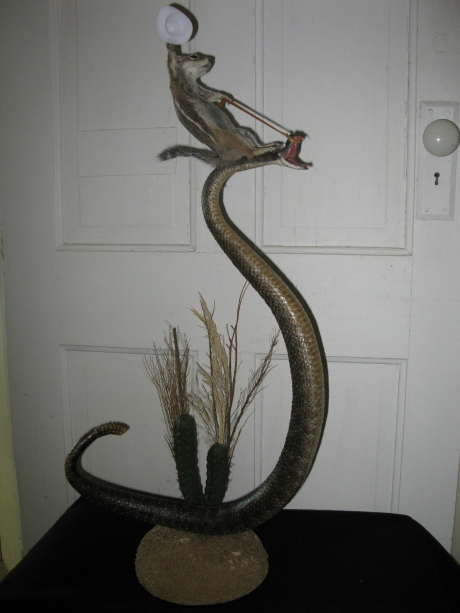

Princess Mononoke (1997)


Princess Mononoke (1997)

Every day hundreds of tourists take pictures of the “Duomo”, the Milan gothic cathedral. But very few of them notice a curious creature, depicted in the bas relief that surrounds the main gate of the church.
While the body looks distinctly dog like, the creature has a long neck, a dinosaur-like head, and webbed feet. The city of Milan has strong historical links with dragons and the symbol of the city is the “biscione” or "great snake."
However in this image, unlike the fierce “biscione” which is depicted as a fierce monster chomping a little boy in its jaws, this dinosaur-dog-dragon has a friendly look and is seemingly depicted eating a leaf.
Built over five centuries between 1386 and 1805, it is unclear exactly when this strange creature was added (likely much later in the process) or why the carver did so. Whether it was a flight of fancy like the gargoyles that decorate the church, had specific symbolism that is now lost, or was the attempt to represent some real creature remains a mystery.
Read more about Milan's Duomo "Dinosaur" on Atlas Obscura...
Category: Architectural Oddities
Location:
Edited by: giorgiobranca, Annetta, Rachel



“I was fascinated by the seemingly comforting strong dresses, and related this form of protective care to my own experiences in hospital and encounters with modern day psychiatric care. My aim was to create a representation of the pieces which lay somewhere between documentary and poetry, incorporating my love of abstraction yet offering a clear portrayal of the pieces for the viewer to interpret themselves." --Jane Fradgley, HeldLast week a friend brought me to see a wonderful exhibition of photography by artist Jane Fradgley; the body of work, entitled "Held," responds to a collection of "strong clothing"--i.e. restraint clothing used in 19th century asylums--kept in the stores of Bethlem Royal Hospital and Museum. The exhibition will be on view in Atrium 2 of Guy's Hospital through March 8, 2013. You can see a few of Fradgley's strikingly uncanny photographs above, but I highly recommend you visit them in person if you can to get a real sense of scale (they are printed life-sized) and emotive impact.
Held
by Jane Fradgley
Funded by Guy’s & St Thomas’ Charity
Atrium 2
Guy’s Hospital
7th November 2012 – 8th March 2013
This new photographic exhibition by artist Jane Fradgley is informed by the collection of strong clothing housed at the Bethlem Royal Hospital Archive & Museum, Beckenham, Kent. The history of this largely unexplored area of mental health care is both powerful and poignant. Through investigation, the artist’s intention is to open new dialogue and debate around protection and restraint in mental health practice. With a background as a fashion designer and a passionate interest in functional and tailored garments, Fradgley was inspired to delve into the archive after seeing Victorian portrait photographs of patients at Bethlem wearing unusual quilted dresses.
“I was fascinated by the seemingly comforting strong dresses, and related this form of protective care to my own experiences in hospital and encounters with modern day psychiatric care. My aim was to create a representation of the pieces which lay somewhere between documentary and poetry, incorporating my love of abstraction yet offering a clear portrayal of the pieces for the viewer to interpret themselves. I enjoyed the intimacy when alone with the garments, and felt closer to them by zooming in on details. One by one the pieces were carefully brought to me like offerings for my lens. They appeared reverential and it seemed fitting to respect this when arranging them in a staged setting in the studio. As each session passed I grew very fond of the pieces, perhaps my own projection but I felt as though they had certain characters. I hoped to convey the essence of the people who wore each garment as I felt great energy from the textiles - possibly there were many wearers and many stories never to be told. I had never imagined that these old garments would hold so much emotive substance. For me the purpose of the strong clothing was not to invoke or exacerbate fear or anxiety in the patient, rather the attention to detail in creating such well constructed garments was to bring some dignity, serenity, peace and tranquility to the wearer as an antidote to their anguish. Wishing to engage with that sense of calm, I explored soft lighting techniques, however some of the garments responded best in the darkness of the shadows, a reminder of the inevitable blackness of mental illness”.You can find out more about Jane Fradgley's work by clicking here.Thanks so much to Jane for the images and materials, and to Phil Loring for introducing me to her work.
Strong clothing was a rather euphemistic term used to describe certain forms of restraint used in late 19th century asylums. While chains, strait-jackets (known as strait-waistcoats) and similar garments were outlawed during the ‘non-restraint’ movement of the 1840s and ’50s, other methods of ‘mechanical restraint’ were permitted by the Commissioners in Lunacy (the government body who inspected and licensed asylums for much of the 19th century). The intention of strong clothing (including strong dresses and padded gloves) was to protect patients, both preventing self-inflicted injury and the destruction of their clothing.
“Strong dresses,” as described by Bethlem Superintendent George Savage in 1888, were “made of stout linen or woollen material, and lined throughout with flannel. The limbs are all free to move, but the hands are enclosed in the extremities of the dress, which are padded. …There are no strait-waistcoats, handcuffs, or what may be called true instruments of restraint in Bethlem”. Savage claimed that, by avoiding recourse to the use of sedatives or padded cells for violent or destructive patients, many “were thus really granted liberty by means of the slight restraint put upon them”.
The terms, descriptions and types of garment used were fraught with meaning for contemporaries, many of whom saw themselves as enlightened humanitarians. Others, however, did not agree, and the ‘principle of non-restraint’ remained an ongoing matter of debate. By the turn of the 20th century strait-jackets appeared to have returned to some institutions. Although the exact dates of the garments seen in these photographs are unknown, given the types of garments reported by the Commissioners in Lunacy as in use at this time, it is likely that they were adopted in the period 1880 –1920.
Through this historical perspective, held reminds us of the difficulty of placing a clear line between care, cure and control in a mental health context. Treatment providers invariably have to make extremely difficult decisions, indicating the importance of opening up debate around physical restraint and chemical intervention in mental health care today.
We are planning a symposium on the subject in 2013, if you would like to be informed about or participate in that symposium contact Sarah Chaney at s.chaney@ucl.ac.uk.

Babs Campion, King, February 1970.
Stephanie FernandesARTE.

Stephanie Fernandesdesde os oito anos de idade, quando ganhei a fita para Mega Drive, acredito que ela seja o próprio Pac-Man travestido.

O grupo de humor Monty Python tem algumas semelhanças-chave com a maior banda do mundo, os Beatles.
Os Python são os os Beatles da comédia, influenciando enorme parte dos programas de humor que vieram depois.
De Saturday Night Live a Casseta & Planeta, de Simpsons a South Park, quase todo humor escrito em grupo vai buscar algum tipo de inspiração nesses seis gênios britânicos.

Atrás: Graham Chapman, Eric Idle, Terry Gillian; na frente: Terry Jones, John Cleese, Michael Palin
Diversos dicionários de língua inglesa incluem a palavra “Pythonesque” – se inventam uma palavra para descrever o seu tipo de humor, pode ter certeza que ele virou referência mesmo.
Aliás, a palavra spam, que você certamente conhece, se deve a um dos mais famosos quadros (esquetes) do programa de TV que eles fizeram por 4 anos, o Monty Python’s Flying Circus.
Se você fizer uma busca no Google por “Monty Python Papodehomem”, verá que já citamos o grupo em muitos, muitos textos, sempre como se todos o conhecessem. Infelizmente, nem todos conhecem. Por isso faço aqui meu Top 5 com os melhores esquetes da série de TV. Assim, você conhecer o que todo mundo quer dizer quando fala do “famoso humor britânico”.
Mas, pra ser sincero… essa lista é ainda mais para quem já conhece os caras.
Os 5 quadros a seguir são os meus favoritos particulares, e, como já presenciei diversas vezes, eleger seus preferidos em uma conversa com outros fãs do grupo é receita certeira para uma discussão. Todo mundo bate o pé, por exemplo, quando digo não acho tanta graça em “A piada mais engraçada do mundo” e “Futebol de filósofos” – embora os considere geniais.
Fique à vontade para questionar minhas escolhas ali nos comentários, e principalmente para indicar links para os seus favoritos.
Link YouTube | O humor do Flying Circus é marcado pela falta de “punchline” (aquela sacadinha final que arranca as maiores risadas), o que explica o final dessa esquete
Link YouTube | Repare como a “tensão” vai aumentando
Link YouTube | John Cleese em sua melhor forma (aliás, dos seis ele é claramente o meu favorito)
Link YouTube | Sem dúvida, uma das mais
Link YouTube | Intraduzível. Icônica. Nonsense.
Link YouTube | Outro grande momento do John Cleese
E agora para algo completamente diferente.
Artigos Relacionados
Stephanie Fernandesamor Highlands.







Flintlock Carbine made by Nicolas Noel Boutet of Versailles, France, 1806. Made for the personal armory of Emperor Napoleon.
Estimate Value: $100,000 - $175,000.